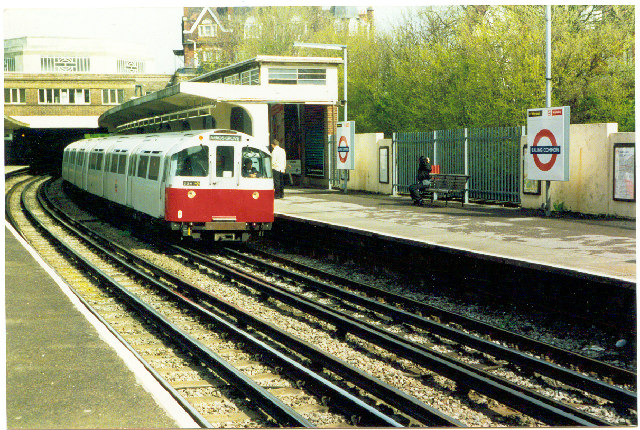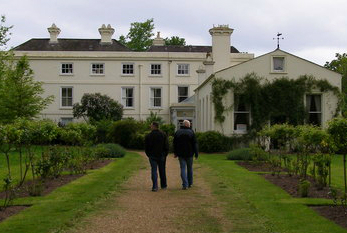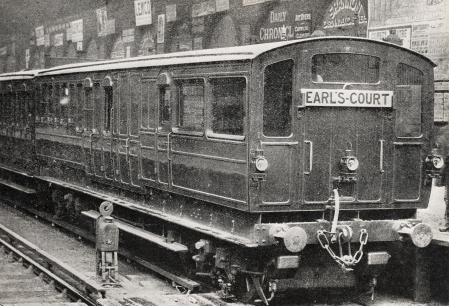|
London Underground 1956 Stock
The London Underground 1956 Stock consisted of three prototype units built before mass production of the 1959 tube stock. These units were tested on the Piccadilly line and remained in service after production trains were introduced. Later they were transferred to the Northern line, but in 1995 they were replaced as non-standard by 1962 Stock cascaded from the Central line. Background The introduction of the 1938 Stock released considerable numbers of Standard Stock trains, which were scheduled to make up the shortfall on the Central line resulting from the extensions to the line. However, this process was interrupted by the Second World War, and although much of the Standard Stock had been through Acton Works for refurbishment, it was stored, as the opening of the extensions was delayed. Further refurbishment was carried out as the extensions opened between 1946 and 1949, but the stock proved to be unreliable after such a long period of storage. With the Piccadilly line al ... [...More Info...] [...Related Items...] OR: [Wikipedia] [Google] [Baidu] |
Birmingham Railway Carriage & Wagon Company
The Birmingham Railway Carriage and Wagon Company (BRC&W) was a railway locomotive and carriage builder, founded in Birmingham, England and, for most of its existence, located at nearby Smethwick, with the factory divided by the boundary between the two places. The company was established in 1854. Production BRC&W made not only carriages and wagons, but a range of vehicles, from aeroplanes and military gliders to buses, trolleybuses and tanks. Nevertheless, it is as a builder of railway rolling stock that the company is best remembered, exporting to most parts of the new and old worlds. It supplied vehicles to all four of the pre-nationalisation "big four" railway companies ( LMS, SR, LNER and GWR), British Rail, Pullman (some of which are still in use) and Wagons-Lits, plus overseas railways with diverse requirement including Egypt, India, Iraq, Malaya, Mandate Palestine, South Africa and Nigeria. The company even built, in 1910, Argentina's presidential coach, whic ... [...More Info...] [...Related Items...] OR: [Wikipedia] [Google] [Baidu] |
Second World War
World War II or the Second World War, often abbreviated as WWII or WW2, was a world war that lasted from 1939 to 1945. It involved the vast majority of the world's countries—including all of the great powers—forming two opposing military alliances: the Allies and the Axis powers. World War II was a total war that directly involved more than 100 million personnel from more than 30 countries. The major participants in the war threw their entire economic, industrial, and scientific capabilities behind the war effort, blurring the distinction between civilian and military resources. Aircraft played a major role in the conflict, enabling the strategic bombing of population centres and deploying the only two nuclear weapons ever used in war. World War II was by far the deadliest conflict in human history; it resulted in 70 to 85 million fatalities, mostly among civilians. Tens of millions died due to genocides (including the Holocaust), starvat ... [...More Info...] [...Related Items...] OR: [Wikipedia] [Google] [Baidu] |
London Underground 1992 Stock
The London Underground 1992 Stock is a type of rolling stock used on the Central and Waterloo & City lines of the London Underground. A total of 85 eight-car trains were built for the Central line and 5 four-car trains were built for the Waterloo & City line. Construction The 1992 Stock was built by British Rail Engineering Limited (BREL) (under ABB) for the Central line following extensive testing of the three 1986 tube stock prototype trains. Even so, the introduction of this stock was far from trouble-free and there were many technical teething problems that had to be ironed out. Eighty-five 8-car trains were ordered from BREL, each formed of four two-car units (two units had driving cabs, the others were fitted with shunting controls). Upon entering service in April 1993, the new trains gradually replaced the previous 1962 tube stock, which was completely withdrawn two years later. The trains were manufactured at the Derby Litchurch Lane Works. The propulsion for t ... [...More Info...] [...Related Items...] OR: [Wikipedia] [Google] [Baidu] |
London Underground 1973 Stock
The London Underground 1973 Stock is a type of rolling stock used on the Piccadilly line of the London Underground. It was introduced into service in 1975 with the extension of the line to Hatton Cross, followed by a further extension to Heathrow Central in 1977. A total of 86 six-car trains were built. The trains were built by Metro-Cammell between 1974 and 1977, and were refurbished by Bombardier Transportation between 1996 and 2001. They are some of the oldest trains running on the Underground, and in Britain as a whole, second only to the 1972 Stock running on the Bakerloo line. History In the early 1970s London Transport placed an order for a new fleet of trains to replace the 1938 Stock and 1959 Stock vehicles which previously operated on the Piccadilly line. Built between 1974 and 1977 by Metro Cammell in Birmingham, the first unit entered service on 19 July 1975 and the last was introduced by 1977. The trains featured longer cars and larger door space than the p ... [...More Info...] [...Related Items...] OR: [Wikipedia] [Google] [Baidu] |
Morden London Underground (5)
Morden is a district and town in south London, England, within the London Borough of Merton, in the ceremonial county of Greater London. It adjoins Merton Park and Wimbledon to the north, Mitcham to the east, Sutton to the south and Worcester Park to the west, and is around south-southwest of Charing Cross. Prior to the creation of Greater London in 1965, for local government purposes, Morden was in the administrative and historic county of Surrey. At the 2011 Census, Morden had a population of 48,233, including the wards of Cannon Hill, Lower Morden, Merton Park, Ravensbury and St Helier. Morden Hall Park, a National Trust park on the banks of the River Wandle adjacent to the town centre, is a key feature of the area. Origin of name Morden's name may be derived from the Common Brittonic words ''Mawr'' (great or large) and ''Dun'' (fort), or possibly "The Town on the Moor". History Early history Human activity in Morden dates back to the Iron Age period when Celt ... [...More Info...] [...Related Items...] OR: [Wikipedia] [Google] [Baidu] |
Associated Electrical Industries
Associated Electrical Industries (AEI) was a British holding company formed in 1928 through the merger of the British Thomson-Houston Company (BTH) and Metropolitan-Vickers electrical engineering companies. In 1967 AEI was acquired by GEC, to create the UK's largest industrial group. A scandal that followed the acquisition is said to have been instrumental in reforming accounting practices in the UK. Main subsidiaries * Metropolitan-Vickers (Metrovick) * British Thomson-Houston (BTH) * Ferguson, Pailin & Co (switchgear) * Edison Swan (lamps and radio valves) * AEI Lamp and Lighting * Siemens Brothers & Co (cables, telephone equipment and railway signaling apparatus) * Hotpoint (domestic appliances) * Premier Electric Heaters (incorporated into Hotpoint) * W.T. Henley (cables, insulators and low voltage switchgear) * Newton Victor (X-ray machines) * Sunvic Controls (heating controls) * Birlec (industrial electric furnaces) * International Refrigerator Company * Cold ... [...More Info...] [...Related Items...] OR: [Wikipedia] [Google] [Baidu] |
London Underground
The London Underground (also known simply as the Underground or by its nickname the Tube) is a rapid transit system serving Greater London and some parts of the adjacent counties of Buckinghamshire, Essex and Hertfordshire in England. The Underground has its origins in the Metropolitan Railway, the world's first underground passenger railway. Opened on 10 January 1863, it is now part of the Circle, District, Hammersmith & City and Metropolitan lines. The first line to operate underground electric traction trains, the City & South London Railway in 1890, is now part of the Northern line. The network has expanded to 11 lines, and in 2020/21 was used for 296 million passenger journeys, making it one of the world's busiest metro systems. The 11 lines collectively handle up to 5 million passenger journeys a day and serve 272 stations. The system's first tunnels were built just below the ground, using the cut-and-cover method; later, smaller, roughly circular tu ... [...More Info...] [...Related Items...] OR: [Wikipedia] [Google] [Baidu] |
District Line
The District line is a London Underground line running from in the east and Edgware Road in the west to in west London, where it splits into multiple branches. One branch runs to in south-west London and a short branch, with a limited service, only runs for one stop to . The main route continues west from Earl's Court to after which it divides again into two western branches, to Richmond and . Printed in green on the Tube map, the line serves 60 stations (more than any other Underground line) over . It is the only Underground line to use a bridge to traverse the River Thames, crossing on both the Wimbledon and Richmond branches. The track and stations between and are shared with the Hammersmith & City line, and between and and on the Edgware Road branch they are shared with the Circle line. Some of the stations between and are shared with the Piccadilly line. Unlike London's deep-level lines, the railway tunnels are just below the surface, and the trains are of ... [...More Info...] [...Related Items...] OR: [Wikipedia] [Google] [Baidu] |
London Underground R Stock
The London Underground R Stock electric multiple units were used on London Underground's District line from 1949 to 1983. Composed of new cars and converted Q38 Stock trailers, the cars were built and converted in three batches between 1949 and 1959. The cars were driving motors (DM) or non-driving motors (NDM), there being no unpowered trailers. The second batch, introduced in 1952, was constructed from aluminium, saving weight and one train was left unpainted as an experiment. Considered a success, trains were left unpainted or painted white or grey to match in 1963–68. Originally designed to operate in trains with six off-peak and eight cars during peak hours, the trains were reformed as fixed seven-car trains in 1971. R Stock trains were replaced by the D78 Stock and withdrawn between 1981 and 1983. Construction After World War II it was decided to replace the London Underground trains that remained with hand-operated sliding doors. R Stock was ordered to replace such tra ... [...More Info...] [...Related Items...] OR: [Wikipedia] [Google] [Baidu] |
London Underground Standard Stock
The Standard Stock title was applied to a variety of Tube stock built between 1923 and 1934, all of which shared the same basic characteristics, but with some detailed differences. This design is sometimes referred to as 1923 Tube Stock, 1923 Stock, or Pre 1938 Stock. Most of the Standard Stock was built to replace the first generation of "Gate Stock" Tube trains or to provide additional trains for extensions built in the 1920s and early 1930s. Standard Stock cars consisted of motor cars, with a driver's cab, behind which was a "switch compartment" occupying approximately one-third of the length of the car, plus trailer cars and "control trailers", with a driving cab but no motor. All were equipped with air operated sliding doors. The guard's door on the earlier trains was a manually operated, inward-opening hinged door. 1922 Stock prototype cars For evaluation purposes, in anticipation of the large number of cars that were to be built over the next several years, six experimen ... [...More Info...] [...Related Items...] OR: [Wikipedia] [Google] [Baidu] |
Gloucester Railway Carriage & Wagon Company
Gloucester Railway Carriage and Wagon Company (GRC&W) was a railway rolling stock manufacturer based in Gloucester, England from 1860 until 1986. Products included goods wagons, passenger coaches, diesel multiple units, electric multiple units and various special-purpose vehicles. The company supplied the original fleet of red trains for the Toronto Subway, which were based upon similar vehicles to the London Underground. The company also produced pivoting sections for the Mulberry Harbour for the British War Office 1944. 19th century The company was formed at a meeting of 30 January 1860 with an initial capital of £100,000 in 10,000 shares of £10 each. The first general manager was Isaac Slater. A works was established in 1860, producing over 300 wagons in the first year. Through the latter part of the 19th century, the company manufactured wagons and carriages. In 1887 it was renamed the ''Gloucester Railway Carriage and Wagon Company'' from the ''Gloucester Wagon Compan ... [...More Info...] [...Related Items...] OR: [Wikipedia] [Google] [Baidu] |
London Underground 1938 Stock
The London Underground 1938 Stock was a London Underground tube stock design. A total of 1,121 cars were built by Metro-Cammell and Birmingham RC&W. An additional 173 cars were added to the fleet by the end of 1953, comprising 91 new builds (the 1949 Tube Stock), 76 conversions from Pre-1938 Tube Stock or 1935 Tube Stock, and six unconverted cars of 1935 Tube Stock, and the stock was used on the London Underground until 1988. During their long lives they worked on the Bakerloo, Northern, Piccadilly, East London and Central lines. Ten sets were refurbished and ran on the Isle of Wight as Class 483, making them the oldest passenger rolling stock operating timetabled services on the National Rail network at the time of their withdrawal in January 2021. The trains represented a major technical advance, as all the electrical equipment was located under the floor for the first time. All previous tube stock had large equipment compartments behind the driving cabs in motor ca ... [...More Info...] [...Related Items...] OR: [Wikipedia] [Google] [Baidu] |






.jpg)

